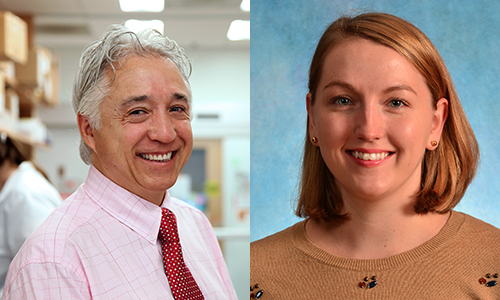Findings from the study led by UNC Lineberger member J. Victor Garcia, PhD, and postdoctoral researcher Jenna Honeycutt, PhD, reveal a second target for cure research.

HIV cure research to date has focused on clearing the virus from T cells, a type of white blood cell that is an essential part of the immune system. Yet investigators in the Division of Infectious Diseases at the University of North Carolina School of Medicine have found the virus persists in HIV-infected macrophages. Macrophages are large white blood cells found in tissues throughout the body including the liver, lung, bone marrow and brain. The discovery of this additional viral reservoir has significant implications for HIV cure research. These findings were published in Nature Medicine on Monday, April 17.
“These results are paradigm changing because they demonstrate that cells other than T cells can serve as a reservoir for HIV,” said Jenna Honeycutt, Ph.D., lead-author and postdoctoral research associate in the UNC Division of Infectious Diseases. “The fact that HIV-infected macrophages can persist means that any possible therapeutic intervention to eradicate HIV might have to target two very different types of cells.”
Last spring, this laboratory lead by J. Victor Garcia, PhD, a UNC Lineberger Comprehensive Cancer Center member and professor of medicine, microbiology and immunology at UNC School of Medicine, demonstrated the ability of tissue macrophages to support HIV replication in vivo in the total absence of human T cells. But how macrophages would respond to antiretroviral therapy (ART) and whether macrophages represented a reservoir for HIV after treatment were unknown.
Macrophages are myeloid lineage cells that have been implicated in HIV pathogenesis and in the trafficking of virus into the brain. Using a humanized myeloid-only mouse (MoM) model devoid of T cells, Garcia and his team showed that ART strongly suppresses HIV replication in tissue macrophages. Yet when HIV treatment was interrupted, viral rebound was observed in one third of the animals. This is consistent with the establishment of persistent infection in tissue macrophages.
“This is the first report demonstrating that tissue macrophages can be infected and that they respond to antiretroviral therapy,” Honeycutt said. “In addition, we show that productively infected macrophages can persist despite ART; and most importantly, that they can reinitiate and sustain infection upon therapy interruption even in the absence of T cells – the major target of HIV infection.”
Now that Garcia and his team know HIV persists in macrophages, the next step will be to determine what regulates HIV persistence in tissue macrophages, where in the body persistently infected macrophages reside during HIV treatment and how macrophages respond to possible therapeutic interventions aimed at eradicating HIV from the body.The UNC School of Medicine team collaborated with scientists in UNC’s Department of Biostatistics, the Theoretical Division at Los Alamos National Laboratory, Veterans Affairs San Diego Healthcare System, and the Departments of Medicine and Pathology at the University of California at San Diego. This study was funded by the National Institute of Mental Health and the National Institute of Allergy and Infectious Diseases of the U.S. National Institutes of Health.
The mission of UNC’s Institute for Global Health & Infectious Diseases is to harness the full resources of the University and its partners to solve global health problems, reduce the burden of disease, and cultivate the next generation of global health leaders. Learn more at www.globalhealth.unc.edu.
